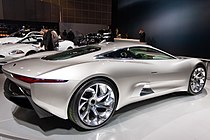Jaguar C-X75
| Jaguar C-X75 | ||
|---|---|---|
Kerb weight 1,700 kg (3,748 lb)[1] | | |
| Chronology | ||
| Predecessor | Jaguar XJ220 (spiritual) | |
The Jaguar C-X75 is a
In May 2011 Jaguar announced a limited production of the C-X75 from 2013 to 2015, with a compact, forced induction petrol engine combined with electric motors instead of the micro gas turbines in the concept car. A maximum of 250 cars were planned to be built in partnership with Williams Advanced Engineering. The production version was expected to have an
Engine and performance
In terms of performance, Jaguar envisioned a goal of their future sports car reaching 330 km/h (205 mph) and accelerating from 0 to 100 km/h (0 to 62 mph) in 2.9 seconds and 80 to 145 km/h (50 to 90 mph) in 2.3 seconds. It is powered by four 145 kW (194 hp) electric motors – one for each wheel – which have a total of 780 hp (582 kW) and a total torque output of 1,600 N⋅m (1,180 lbf⋅ft). Inherent in the drivetrain is the ability to independently drive each wheel across the full speed range, known as
The micro gas turbines from
Jaguar also focused on the aerodynamics in order to improve performance. For example, the carbon-fibre rear diffuser that guides airflow from under the car creates down-force, and includes an active aerofoil that is lowered automatically as speed increases, creating over 200 kg (440 lb) of downforce at 321 km/h (199 mph).[12] Moreover, the C-X75 features an extruded and bonded, aerospace-inspired, aluminium chassis, saving weight and improving sustainability and performance.[10]
Production
In May 2011 Jaguar unveiled plans to produce the C-X75; the company had planned to produce a maximum of 250 cars in partnership with Williams Advanced Engineering. The decision was part of a £5 billion investment plan, announced by Jaguar Land Rover (JLR) in March 2011 at the
The C-X75 was to be built without the micro-turbines, instead, the production version would use a downsized, forced induction petrol engine, with one electric motor at each axle. In order to create a lightweight strong structure, the chassis was planned to be made of
Cancellation
In December 2012, Jaguar's Global Brand Director announced the cancellation of production due to the then still ongoing
Appearance in Spectre

A Jaguar C-X75 (painted in dark orange) appears in the 2015 James Bond film
Confusion of how many C-X75 exist
There is confusion of how many C-X75 exist. WAE (who worked on the cars) say on their website that six stunt cars were commissioned and seven cars were produced.[15] However an official photo taken by Jaguar shows only 6 cars to exist.[16] Kaaimans International (who are selling one of the cars), says only 4 stunt cars had been produced.[17] Furthermore, this is an agreed upon number by the car's designer, Ian Callum, in a two part article where he states four were built specifically for the film.[18] However, in the book Bond Cars: The Definitive History[19] it says there are 7 cars but doesn't distinguish between V8-powered stunt cars and the engineering prototypes.[19] Octane also agrees on 7 cars[20] along with a Top Gear magazine article that states "They built seven. Two are ‘star cars’, cosmetically perfect specimens with proper glitzy interiors; the other five are grafters, used for skidding about and doing the fun stuff".[21]
See also
- Jaguar C-X16 – Jaguar's smaller 2011 hybrid 2-seat sports car concept
- List of modern production plug-in electric vehicles
References
- ^ a b c d e f g h i Pulman, Ben (21 June 2013). "Jaguar C-X75 (2013) review". CAR magazine. Retrieved 12 March 2018.
- ^ "YASA Motors' Work for Jaguar Land Rover Wins Industry Commendation" (Press release). YASA. 26 November 2013. Archived from the original on 7 July 2017. Retrieved 8 July 2016.
- ^ "First Look: Jaguar C-X75 Concept". Motor Trend. 28 September 2010. Archived from the original on 11 August 2011. Retrieved 9 October 2010.
- ^ a b c Tim Pollard (1 October 2010). "Jaguar C-X75 concept (2010) diesel electric supercar". CAR magazine.
- ^ a b c "Jaguar to build C-X75 hybrid supercar with Williams F1". Green Car Congress. 6 May 2011. Retrieved 6 May 2011.
- ^ a b Jorn Madslien (6 May 2011). "Jaguar to build £700,000 hybrid supercar with Williams". BBC News. Retrieved 6 May 2011.
- ^ a b Mark Tisshaw (11 December 2012). "Jaguar C-X75 axed". Autocar. Retrieved 11 December 2012.
- ^ Moss, Darren (9 February 2015). "Jaguar C X75 in James Bond film Spectre". Autocar. Retrieved 14 February 2015.
- ^ New York Times. Retrieved 6 October 2010.
- ^ a b c d "Jaguar Introduces C-X75 Gas Micro-turbine Extended Range Electric Vehicle Concept". Green Car Congress. 30 September 2010. Retrieved 6 October 2010.
- ^ Steve Cropley (3 December 2010). "Jaguar C-X75 Concept First Drive". Edmunds InsideLine.
- ^ a b "Jaguar's C-X75 Concept Car - Explore This Model". Land Rover. Retrieved 24 November 2023.
- ^ Block, Fang (11 November 2019). "Jaguar C-X75 Stunt Car From Bond Film 'Spectre' Heads to Auction". Barron's. US. Retrieved 13 June 2020.
- ^ Tisshaw, Mark (16 October 2015). "Aston Martin DB10 special – from Gaydon with love". Autocar. Retrieved 27 October 2015.
- ^ "Spectre – stunt cars". WAE. UK. Retrieved 20 December 2023.
- ^ "C-X75". Bauer Secure. Retrieved 20 December 2023.
- ^ "Used cars". Kaaimans International. Retrieved 20 December 2023.
- ^ Callum, Ian (21 July 2023). "Creating the Jaguar C-X75: Part one". The intercooler. Retrieved 20 December 2023.
- ^ ISBN 978-1785945144.
- ^ Dixon, Mark [@OctaneMark] (17 August 2023). "We reckoned seven in total, from this Octane article when the movie came out. Looks as though Stuart Davies at JLR is the man to track down" (Tweet). Retrieved 20 December 2023 – via Twitter.
- ^ Marriage, Ollie (8 November 2015). "Bond special: driving SPECTRE's very evil Jaguar C-X75". Top Gear magazine. UK. Retrieved 20 December 2023.




